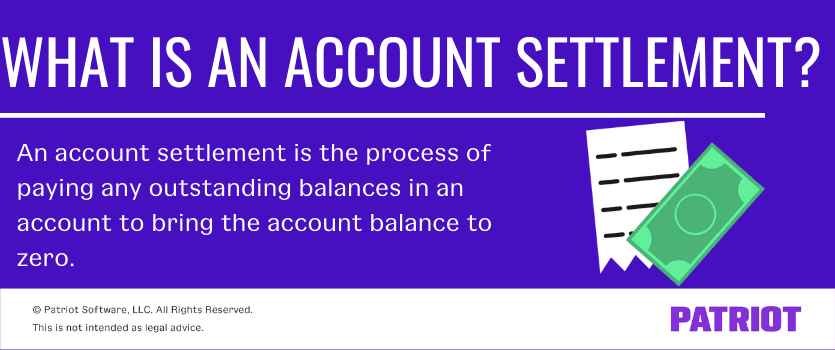When you run a business, you need to know a little bit about accounting. One of the things to know is account settlement. The settlement of an account can be crucial, especially if you use clearing accounts. What is an account settlement? Why is it important? When should you settle your accounts? Learn all of this and more by reading on.
What is an account settlement?
An account settlement, or settlement of accounts, is the action of paying off any outstanding balances to bring an account balance to zero.
To settle an account can also mean completing the offset process between two or more parties in an agreement. If two or more parties agree to an offset, they may agree to exchange goods or services rather than money. Or, the parties may agree to pay a lower price in exchange for goods or services. This results in one or more parties having a positive balance.
For example, you have one outstanding balance in an account. Customer A owes the entirety of the balance because of Invoice A. When Customer A pays the invoice, the account is now settled.
Basically, the settlement of the account is the actual exchange of money or another value (such as goods or services) to pay off the account.

Is an account settlement for asset or liability accounts?
You can settle both asset and liability accounts.
When an individual or company owes your business, the account is an account receivable (i.e., an asset account).
If you record payments you owe to a lender or other business until you pay off the funds you owe, the account you settle is an account payable (i.e., a liability account).
Account settlements and clearing accounts
Settling an account often occurs with clearing accounts. What is a clearing account? A clearing account is either a:
- Bank account used to hold funds until payments can move to another account (e.g., payroll accounts to employee bank accounts), OR
- Temporary account used to record transactions in the general ledger until the funds can be accurately or completely classified
You may choose to hold multiple payments in the clearing account until you receive the total balance due on an invoice.
For example, Company A has an invoice for a total of $5,000. Company A sends five payments of $1,000 each for the invoice payments. You hold each payment in the clearing account until you receive the total of $5,000. After you receive the final payment, the account is settled, and you can close the clearing account.
Examples of account settlements
Settling your accounts can be confusing, especially since there are several different ways you can do so. Here are some examples of account settlements.
Example 1
Your company opens a loan account with Bank A for $10,000. The bank’s agreement is for five years plus interest. For five years, you make payments on time. When you make the final payment, you settle the account with the bank.
Example 2
You open a loan account with Bank B for $20,000 to be paid off over five years. After three years, you still owe $8,000. However, you run into a financial hardship that prevents you from making your monthly loan payment.
So, you speak with your bank and devise a plan for a one-time settlement. The bank agrees that you can take some time off from your current repayment plan. But, Bank B requires you to make a one-time payment of $8,000 to settle your account.
After you take some time off from repayments, you have the funds to pay off the remaining balance. When you make the settlement payment, the account is now settled.
Example 3
To keep your company’s bank account secure, you use a secondary payroll clearing account. Before you pay your employees, you transfer the funds for their paychecks and the taxes to the clearing account. As employees deposit their paychecks, those checks clear the account.
But, the taxes sit in the clearing account until you make the payments to the appropriate tax agency. After the employees deposit their checks and you remit the taxes, the clearing account balance is zero. So, you settled the account.
Example 4
Your business manufactures lumber, and you need an addition built on your retail store. You work with a construction company that specializes in building construction, Company B. So, you agree to supply the necessary lumber to Company B in exchange for them building the addition on your retail store.
The value of the addition to your store is higher than the value of the lumber. But, the account settlement takes place when you complete the transaction. The credit balance goes to Company B, but the account is settled.
Even though the values of the two are not equal, the exchange of value in the agreement settled the account.
Example 5
You have one outstanding balance in an account in your books. Customer A owes the entirety of the balance and has only one invoice. Company A sends one lump-sum payment for their outstanding invoice. When Customer A pays the invoice and you record the transaction, the account is now settled.
Settlement accounts vs. account settlements
So, what is the difference between settlement accounts and account settlements? Despite the names being so similar, there is quite a difference between the two.
Again, account settlements are when you settle outstanding balances either through payments or offsets.
But, settlement accounts are bank accounts used to track the balances of payments between banks. International balance of payment accounting uses settlement accounts to track the funds in the central banks’ reserve asset transactions. The reserve transactions typically involve gold, foreign exchanges, bank deposits, and other international funds.
Settlement accounts usually only track funds related to nations settling deficits or surpluses in the balance of payments. Countries also monitor their incoming and outgoing funds between other countries with settlement accounts.
Settlement date accounting
When you settle your accounts, you are typically doing so because you recorded transactions in anticipation of receiving funds or making payments. However, settlement date accounting is a method you can use to enter the information in your books only when you fulfill the transaction.
With settlement date accounting, enter the transactions into your general ledger when the transaction happens. This method ensures that everything on your general ledger has actually happened with the exact amount recorded. You settle the account at the time you record the transaction.
For example, you apply for a loan from Bank A on December 15, but the bank does not issue the loan until January 15. With the settlement date accounting method, the financial statements from December do not include the loan.
While settlement date accounting lets you know the actual transactions, this method does not allow you to see the impact of potential or upcoming transactions. So, any pending transactions on your balance sheet do not show up on your general ledger. And, transactions that are not on your general ledger do not appear on your company’s other financial statements.
Recording payments and other financial transactions should not be a time-consuming process. Patriot’s online accounting software makes it fast and easy to enter all your bills, invoices, and payments so you can get back to business. Start your free 30-day trial today!
This is not intended as legal advice; for more information, please click here.


